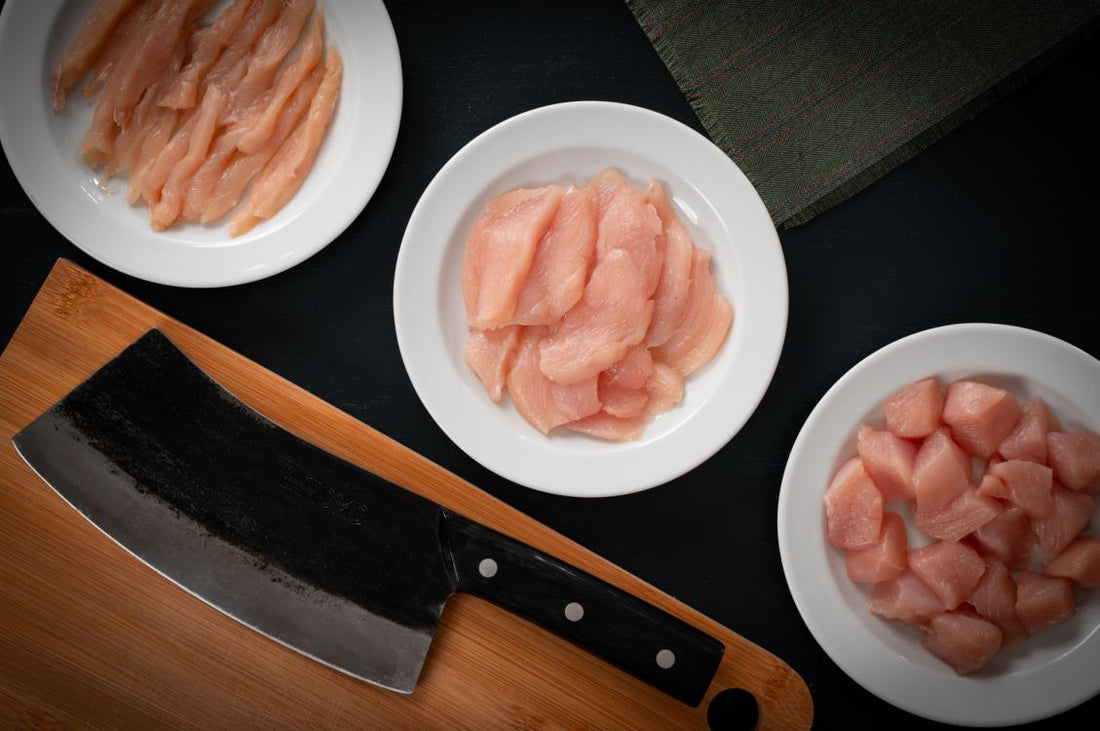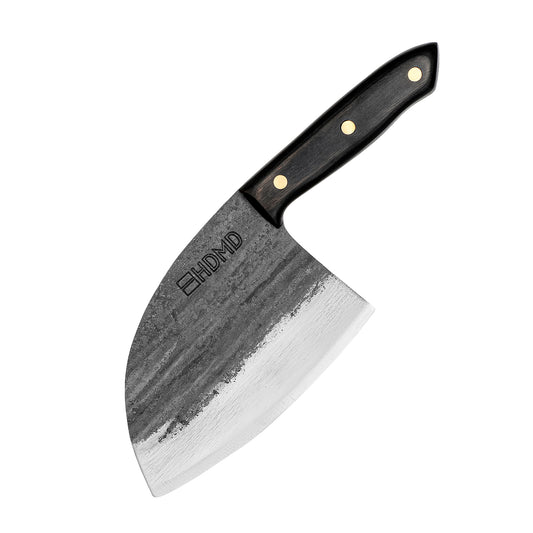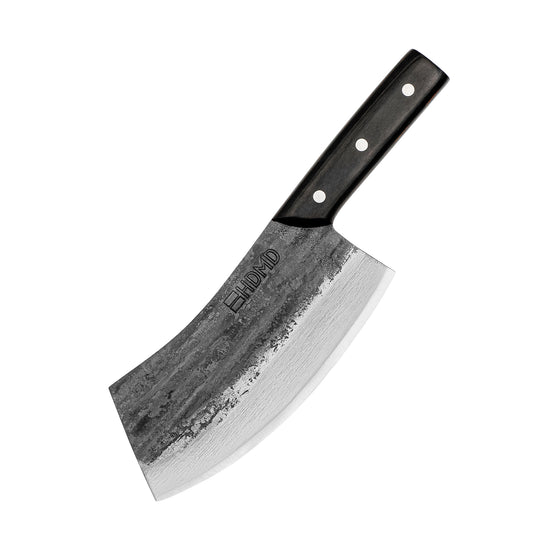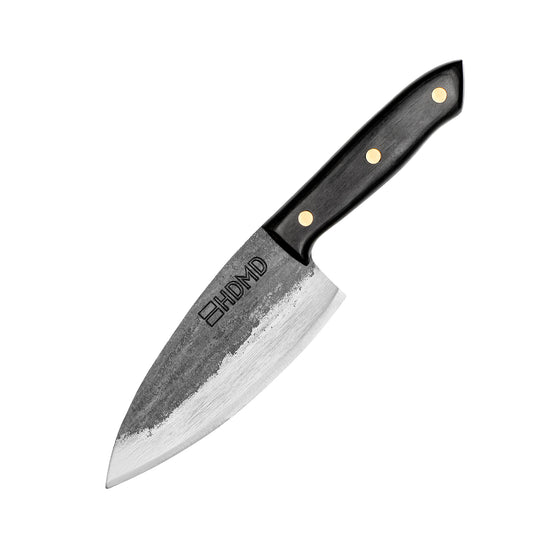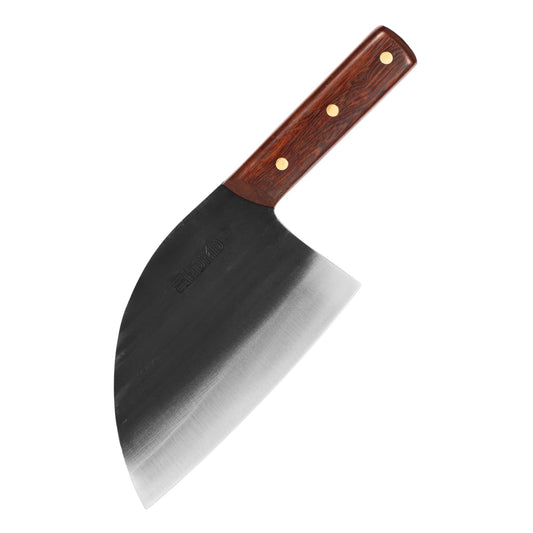The key to having perfectly tenderized chickens when stir-frying them is to cut them appropriately for the cooking process. If you don't cut chickens or other meats for stir-frying correctly, you'll end up with chewy bits that could've been better - even if you cook them flawlessly.
This article will guide you on cutting a chicken breast for stir-fry as it's the most commonly used part of the chicken for this cooking method.
It’s not to say that you can’t follow the same principles with other boneless chicken parts like the thigh. If you prefer the darker cut of chicken with higher fat content, cut the thighs the same way as the breasts.
Prepare the chicken breast
You'll need to cut chicken breast into tiny bits that cook fast and remain tender. The goal with cutting chicken breasts for stir-frying is to have bite-size pieces that cook fast.
Just with everything, cutting a chicken breast for stir-fry begins with some preparation. Although these aren't a must, it'd be better if you did.
Since chicken is relatively slippery and putting some pressure on it when cutting can alter its shape, making it harder to slice, you'll need to follow a standard technique to have an easier time cutting.
Clean and freeze
Pat the chicken breast dry using a paper towel, put it in the freezer for about 15 minutes to semi-froze it. This will give you a better grip and ensure that the slices won't stick to your blade as much, saving you time and effort.
It goes without saying that you also need a very sharp kitchen knife to have perfectly sliced chicken breasts for stir-fry, preferably a chef's knife, like the ones we have in our store.
Know where to cut
Even if you have the best chicken breast and the best set of knives, you won't get great results if you don't know which direction to cut. When cutting chicken breasts or another type of meat for stir-frying, make sure to always cut against the grain. The grain refers to the direction the muscle striations form. Cutting along the grain will give you longer muscle fibers that turn out tough and chewy.
The muscle fibers are much shorter when you cut against the grain, giving you more tender bites. That's why you need to cut against the direction of the muscle fibers, not parallel to them. You can see the direction of the fibers just by simply looking at the breast closely.
Note that a chicken breast doesn't have a uniformed grain that's the same across. The grain runs in a different direction in the breast itself and the tender (fingers) underneath. Separating these two parts before starting to cut for stir-frying is recommended. The same also applies to the thighs. Make sure to give it a thorough look before cutting right away.
Here is how to cut a chicken for stir-frying in three different ways: slice, julienne, and into cubes.
Slice chicken for stir-fry
Slicing the chicken for stir-frying is pretty straightforward, and you'll need to do this anyway, whether you cook it sliced or cut them into cubes or julienne.
Step 1. Take the breast and locate where the grain runs.
Step 2. Cutting against the grain, create 1/4 inch thick slices. Make sure that every slice is at the same thickness so that everything cooks evenly. You don't want to end up with undercooked and overcooked chickens all over your plate.

Here is the chicken slices you'll get:
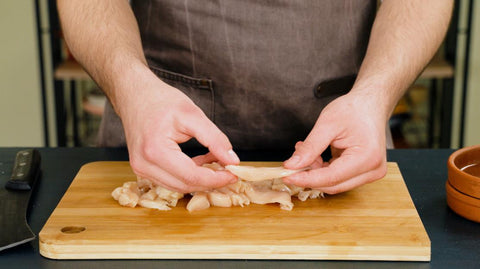
The best cutting technique is curling your fingers over the breast and using your knuckles to guide the blade. This is known as the claw grip, as you're holding your hands in a claw-like position. Read more on how to hold a knife properly.
Julienne chicken
Julienne is the chef's word for strips. The purpose of julienning chicken, along with all the other ingredients, is to create thin, matchstick-sized pieces that cook fast and remain tender.
Step 1. As mentioned above, start by cutting the chicken into 1/4 slices.
Step 2. Stack a few slices on top of each other.

Step 3. Cut the chicken lengthwise into thinner strips.
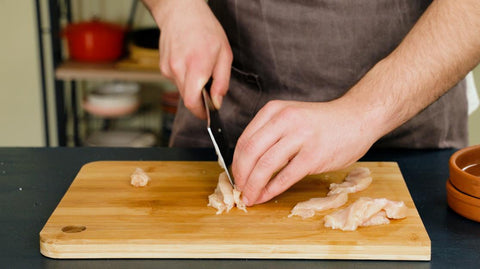
If you're new to cutting ingredients like this, it's best to cut each slice on its own to have a feel for it. Once you're more comfortable, you can stack as many as you can. Remember, it's always about the technique rather than speed. The more you practice each of the different knife cuts, the faster you'll get. Here is what your chicken strips would look like:

Chicken cubes (dice)
The most popular cutting method for stir-frying is to cut everything you're cooking into cubes - in other words, dice. The chicken will cook fast and stay tender when diced like the previously mentioned cutting techniques.
Step 1. Again, cut the chicken into slices. One recommendation before doing this would be cutting narrowly against the grain as opposed to entirely. As you'll cut the breast lengthwise and crosswise once, doing this will give you shorter fibers, meaning more tender bites.

Step 2. Take each slice and cut it lengthwise at the thickness you want the cubes., then put each strip together and cut them into cubes.

The thinner the initial strips, the smaller the cubes, and vice versa. It's crucial to cut the chicken into cubes at the same size in both cuts you make to have uniformed pieces to ensure even cooking.

How to velvet/tenderize chicken for stir-fry?
Velveting chicken is a Chinese method that traps the moisture inside, giving you more tender and juicier bites every time. If you ever wondered how high-end restaurants get their chicken so tender, velveting is often the answer. Here is how to velvet chicken for stir-frying.
- Put the chicken in a bowl and add two tablespoons of water for every 15 ounces to moisten it.
- After the chicken absorbs the water, add soy sauce and soak for five minutes.
- Add a tablespoon of cornstarch and a tiny bit of vegetable oil and blend everything. Let it marinate for 15 minutes.
- While the chicken is marinating, bring a pot of water to boil.
- Reduce the heat to simmer, the lowest heat available.
- Add the chicken after marinating for enough and cook it for about three minutes.
- Drain the chicken and let it cool a little.
Once these are done, you can proceed as usual. Since you've pre-cooked the chicken, you will need to reduce cooking time a little when stir-frying.
FAQs
How to marinate chicken for stir fry quick?
Marinating chicken doesn't have to be time-consuming. When you need to stir-fry chicken quickly, a five-minute soak in soy sauce, cornstarch, and vegetable oil, along with your favorite spices, gets the job done just fine. Undoubtedly, marinating for longer would be better in most cases, but it isn't always a must and better than not marinating at all.
Is stir fry chicken healthy?
Stir-frying chicken with veggies like broccoli or any other vegetable for that matter using minimum oil is a healthy cooking method, especially for those looking to lose weight. Because stir-frying requires little oil, which helps you cut down the calories, it's a beneficial cooking method for gym-goers.
Can you freeze stir fry chicken?
There is nothing wrong with freezing stir-fry chicken. However, you might want to freeze stir-fry that hasn't been cooked yet. There isn't a health risk to freezing stir-fry chicken, but the taste won't be as much on point as you would anticipate. Additionally, you can reheat stir-fry, so if you're going to eat it later in the day or the next day, you can keep it in the refrigerator.
How long to stir fry chicken?
The point of stir-frying is to cook everything at high temperatures while continuously stirring the pan or the wok. Generally, it takes about five minutes to stir-fry chicken. Take two minutes to sear the chicken, add the vegetables, cook for a minute, and bring everything together for one to two minutes with the sauce.
Stir-frying is a practical, time-efficient, and tasty way to cook chicken. With so little time it demands, stir-frying works wonders for many that want to prepare something quickly.
For more kitchen-related tips and guides, read more on our blog and take a look at HDMD Knives collection to shop for handmade kitchen knives that will handle everything at an affordable price.

